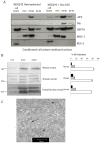Exosomes bind to autotaxin and act as a physiological delivery mechanism to stimulate LPA receptor signalling in cells
- PMID: 27557622
- PMCID: PMC5087657
- DOI: 10.1242/jcs.184424
Exosomes bind to autotaxin and act as a physiological delivery mechanism to stimulate LPA receptor signalling in cells
Abstract
Autotaxin (ATX; also known as ENPP2), the lysophospholipase responsible for generating the lipid receptor agonist lysophosphatidic acid (LPA), is a secreted enzyme. Here we show that, once secreted, ATX can bind to the surface of cell-secreted exosomes. Exosome-bound ATX is catalytically active and carries generated LPA. Once bound to a cell, through specific integrin interactions, ATX releases the LPA to activate cell surface G-protein-coupled receptors of LPA; inhibition of signalling by the receptor antagonist Ki1642 suggests that these receptors are LPAR1 and LPAR3. The binding stimulates downstream signalling, including phosphorylation of AKT and mitogen-activated protein kinases, the release of intracellular stored Ca2+ and cell migration. We propose that exosomal binding of LPA-loaded ATX provides a means of efficiently delivering the lipid agonist to cell surface receptors to promote signalling. We further propose that this is a means by which ATX-LPA signalling operates physiologically.
Keywords: Autotaxin; Exosome; Integrin; LPA.
© 2016. Published by The Company of Biologists Ltd.
Conflict of interest statement
The authors declare no competing or financial interests.
Figures








Similar articles
-
Autotaxin induces lung epithelial cell migration through lysoPLD activity-dependent and -independent pathways.Biochem J. 2011 Oct 1;439(1):45-55. doi: 10.1042/BJ20110274. Biochem J. 2011. PMID: 21696367 Free PMC article.
-
Autotaxin/Lpar3 signaling regulates Kupffer's vesicle formation and left-right asymmetry in zebrafish.Development. 2012 Dec 1;139(23):4439-48. doi: 10.1242/dev.081745. Epub 2012 Oct 24. Development. 2012. PMID: 23095890
-
Autotaxin-LPA axis regulates hMSC migration by adherent junction disruption and cytoskeletal rearrangement via LPAR1/3-dependent PKC/GSK3β/β-catenin and PKC/Rho GTPase pathways.Stem Cells. 2015 Mar;33(3):819-32. doi: 10.1002/stem.1882. Stem Cells. 2015. PMID: 25376707
-
Autotaxin/Lysophosphatidic Acid Axis: From Bone Biology to Bone Disorders.Int J Mol Sci. 2022 Mar 22;23(7):3427. doi: 10.3390/ijms23073427. Int J Mol Sci. 2022. PMID: 35408784 Free PMC article. Review.
-
Biological roles of lysophosphatidic acid signaling through its production by autotaxin.Biochimie. 2010 Jun;92(6):698-706. doi: 10.1016/j.biochi.2010.04.015. Epub 2010 Apr 22. Biochimie. 2010. PMID: 20417246 Review.
Cited by
-
BMSC-Derived Small Extracellular Vesicles Induce Cartilage Reconstruction of Temporomandibular Joint Osteoarthritis via Autotaxin-YAP Signaling Axis.Front Cell Dev Biol. 2021 Apr 1;9:656153. doi: 10.3389/fcell.2021.656153. eCollection 2021. Front Cell Dev Biol. 2021. PMID: 33869221 Free PMC article.
-
Calcium Signaling and Tissue Calcification.Cold Spring Harb Perspect Biol. 2019 Oct 1;11(10):a035303. doi: 10.1101/cshperspect.a035303. Cold Spring Harb Perspect Biol. 2019. PMID: 31138543 Free PMC article. Review.
-
Autotaxin in Breast Cancer: Role, Epigenetic Regulation and Clinical Implications.Cancers (Basel). 2022 Nov 4;14(21):5437. doi: 10.3390/cancers14215437. Cancers (Basel). 2022. PMID: 36358855 Free PMC article. Review.
-
'Crystal' Clear? Lysophospholipid Receptor Structure Insights and Controversies.Trends Pharmacol Sci. 2018 Nov;39(11):953-966. doi: 10.1016/j.tips.2018.08.006. Trends Pharmacol Sci. 2018. PMID: 30343728 Free PMC article. Review.
-
Extracellular vesicles: lipids as key components of their biogenesis and functions.J Lipid Res. 2018 Aug;59(8):1316-1324. doi: 10.1194/jlr.E086173. Epub 2018 May 15. J Lipid Res. 2018. PMID: 29764923 Free PMC article. Review.
References
-
- Baumforth K. R. N., Flavell J. R., Reynolds G. M., Davies G., Pettit T. R., Wei W., Morgan S., Stankovic T., Kishi Y., Arai H. et al. (2005). Induction of autotaxin by the Epstein-Barr virus promotes the growth and survival of Hodgkin lymphoma cells. Blood 106, 2138-2146. 10.1182/blood-2005-02-0471 - DOI - PubMed
-
- Hausmann J., Kamtekar S., Christodoulou E., Day J. E., Wu T., Fulkerson Z., Albers H. M. H. G., van Meeteren L. A., Houben A. J. S., van Zeijl L. et al. (2011). Structural basis of substrate discrimination and integrin binding by autotaxin. Nat. Struct. Mol. Biol. 18, 198-204. 10.1038/nsmb.1980 - DOI - PMC - PubMed
Publication types
MeSH terms
Substances
Grants and funding
LinkOut - more resources
Full Text Sources
Other Literature Sources
Research Materials
Miscellaneous

